
views
Deciding Whether to Draft an Addendum

Identify a significant life event you want to account for. If you are recently remarried or have had more children, then you should account for your new spouse and children in the will. Typically, any gift to a former spouse is revoked automatically on divorce. Nevertheless, you should draft a new will to redistribute any gifts formerly designated for your ex-spouse to new beneficiaries. The general rule today is that a prior will is not automatically revoked because you are married. Instead, your spouse would take an “intestate” share, meaning the share he or she would have gotten had you died without a will.

Identify newly acquired property. If you want to make a specific bequest of a newly acquired piece of property, such as a boat or a new home, then you can name a beneficiary in the addendum. If you are dividing your estate equally between beneficiaries—or leaving everything to one person—then you do not need to draft an addendum simply because you have acquired more property. If you sell a specific piece of property, you also do not need to write an addendum. If you left your car to your brother but sell it before you die, then the car is no longer part of your estate to distribute to your brother.

Choose new beneficiaries. If you leave a piece of property to someone and she dies before you, then you will need to choose someone else to leave it to. What happens to the property when someone predeceases you depends on state law. In some states the gift will fall into the residuary and be distributed to the beneficiaries of your residual estate. In other states the gift will pass to the children of the deceased beneficiary.

Consult with an attorney. Only a lawyer can tell you if the change you want to make is sufficiently minor that a codicil or addendum is sufficient. Try to contact the attorney who drafted the will since she will be more familiar with it than a new attorney.
Drafting the Addendum
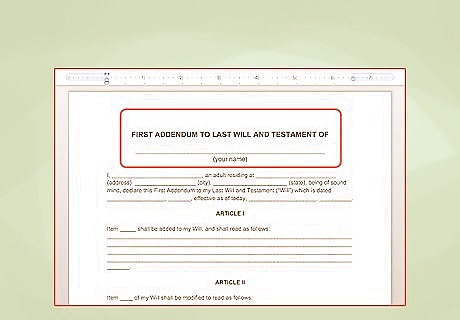
Title the document. Before you begin writing the addendum, you will need to give it an appropriate title to indicate the document’s purpose. “Addendum to the Last Will and Testament of [your full name]” is sufficient.
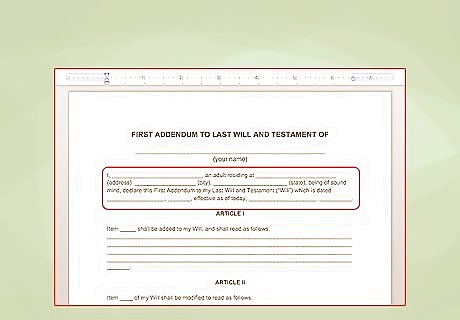
Draft the opening paragraph. The first paragraph will identify you and the document. You can write: “I [your name], [your address – including the city, county and state in which you live], being of sound mind, declare that this Addendum to the Last Will and Testament of [your name] is effective on this date and shall hereby amend my Last Will and Testament dated [insert date of will] as follows:” Include the date of your original will in your addendum. The inclusion of this date shows that you are aware of the original document. It will keep those who interpret your will from thinking that you may have created this document without knowledge of the original will.
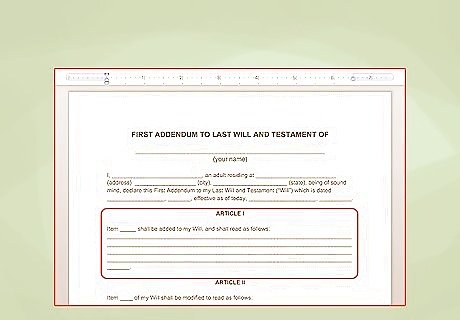
Identify the change you want to make to the will. Make sure that you specify the article number that you want to amend, delete, or add and state in detail what the changes will be. If you want to amend something, you could write: “Article 1 shall be amended to state [State your present and foreseen needs and desires that need to be changed - for example, changing the name(s) of beneficiary(ies) and/or the executor of the will.]” If you want to delete an article, you could write: “Article 1 shall be deleted in its entirety.” If you want to add an article, you could write: “Article 8 is hereby added as follows: [Include additional directives that were not included in your original will - for example, adding a provision that will afford your estate the optimum tax consequences upon your death.]”
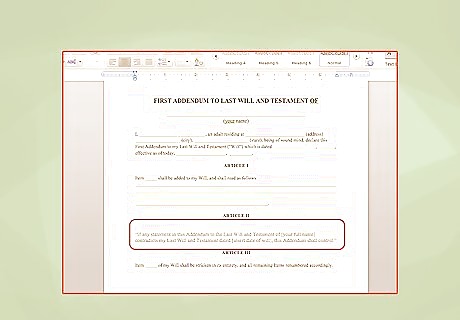
Acknowledge that your addendum will overrule anything in your original will that contradicts it. To accomplish this, you could write: “If any statement in this Addendum to the Last Will and Testament of [your full name] contradicts my Last Will and Testament dated [insert date of will], this Addendum shall control.”

Reaffirm your will. You should write, “In all other respects I reaffirm and republish my will dated [insert the date of the will.]”
Finalizing the Addendum

Ask an attorney to look over the draft. Legal counsel can determine if the text complies with jurisdictional laws and offer suggestions for altering the text. The attorney can also offer advice and assistance arranging for a formal witnessing or review of the document by a notary public.

Sign and date the addendum. In some jurisdictions, this must be done in the presence of witnesses, with all parties identifying the date that the action is taking place. Typically, state law requires two witnesses, none of whom are beneficiaries under the will. There may also be the need for an additional section to the document known as an Attestation. This is simply a verification by the witnesses that they are in agreement that the maker of the will is of sound mind and body, and has created the addendum of his or her own free will, without coercion by any party.
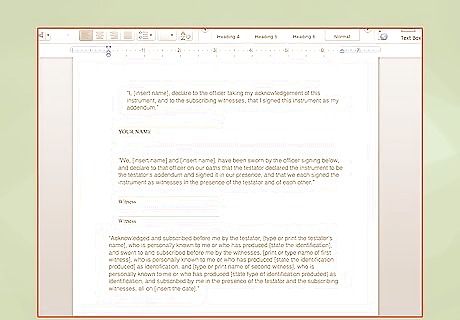
Include a self-executing affidavit. An affidavit will greatly speed up the probate process. To execute the affidavit, sign the will in front of the notary and get the will notarized. Append the following language to the end of the will: “I, [insert name], declare to the officer taking my acknowledgement of this instrument, and to the subscribing witnesses, that I signed this instrument as my addendum.” Then sign your name beneath this language. Insert the following language for the witnesses. “We, [insert name] and [insert name], have been sworn by the officer signing below, and declare to that officer on our oaths that the testator declared the instrument to be the testator’s addendum and signed it in our presence, and that we each signed the instrument as witnesses in the presence of the testator and of each other.” Then have the two witnesses sign beneath this. Then include this language for the notary: “Acknowledged and subscribed before me by the testator, [type or print the testator’s name], who is personally known to me or who has produced [state the identification], and sworn to and subscribed before me by the witnesses, [print or type name of first witness], who is personally known to me or who has produced [state the identification produced] as identification, and [type or print name of second witness], who is personally known to me or who has produced [state type of identification produced] as identification, and subscribed by me in the presence of the testator and the subscribing witnesses, all on [insert the date].” Then have the notary sign and affix official stamp or seal.

Store your addendum with your last will and testament. To ensure the safety of your addendum, you should keep it in the same place as your will, e.g., a home safe or a safety deposit box. If your attorney keeps your will, send the addendum to him or her.















Comments
0 comment